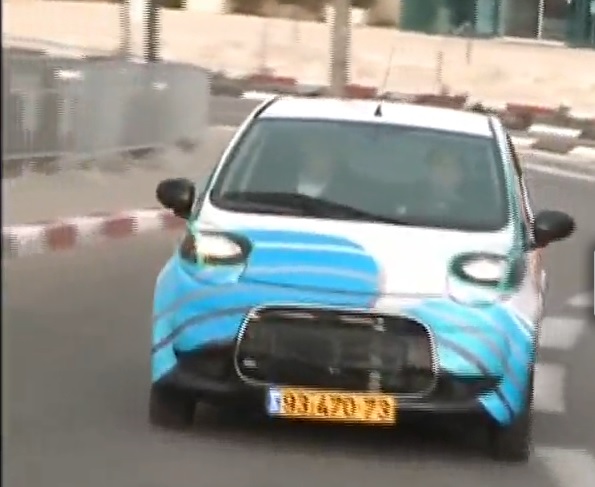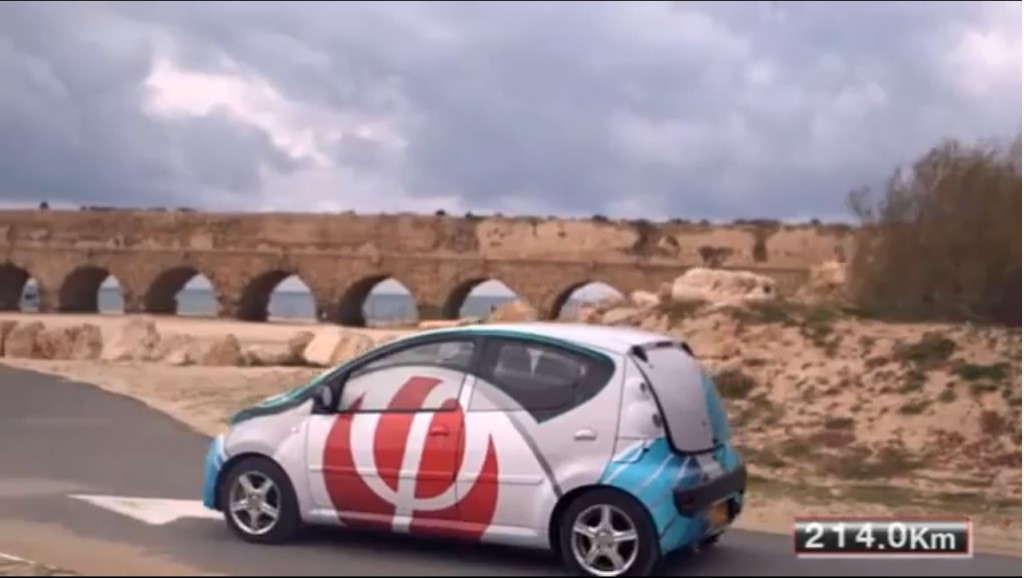It's the sweetest dream of every electric-car fan: a battery that could store enough energy to offer up to 1,000 miles of real-world range.
While it's not going to arrive in showrooms any time soon, Israeli startup Phinergy thinks its aluminum-air energy storage device might just be that battery.
Moreover, say CEO Aviv Tzidon, the company has signed a contract with a global automaker to deliver production volumes of the device starting in 2017.
Which isn't really all that far away in car time, since we're already seeing 2014 model-year cars on the road.
Filling up with water
The Bloomberg clip above, posted last Thursday, comes from reporter Elliott Gotkine driving a Citroen C1 minicar that's been modified to run as an electric car, with a Phinergy cell array mounted in the load bay.
The car's lithium-ion battery provides less than 100 miles of range, but the Phinergy aluminum-air cells acts as a range extender to provide up to an additional 1,000 miles.
The highlight of the video is a technician filling the test car with distilled water, while the projected range is shown rising on a display on the CEO's mobile phone.
The water serves as a base for the electrolyte through which ions pass to give off the energy that powers the test vehicle's electric motor.
In the test car, the water must be refilled "every few hundred kilometers"--perhaps every 200 miles.
Aluminum and air electrodes
Very simply, an aluminum-air battery uses an aluminum plate as the anode, and ambient air as the cathode, with the aluminum slowly being sacrificed as its molecules combine with oxygen to give off energy.
The basic chemical equation (courtesy of Wikipedia) is: 4Al + 3O2 + 6H2O → 4Al(OH)3 + energy
That is, four aluminum atoms, three oxygen molecules, and six water molecules combine to produce four molecules of hydrated aluminum oxide plus energy.
Historically, aluminum-air batteries have been confined to military applications because of the need to remove the aluminum oxide and replace the aluminum anode plates.
Phinergy says its patented cathode material allows oxygen from ambient air to enter the cell freely, while blocking contamination from carbon dioxide in the air--historically a cause of failure in aluminum-air cells.
It is also developing zinc-air batteries, which can be recharged electrically and do not sacrifice their metal electrode as the aluminum-air cells do.

Citroen test car fitted with Phinergy prototype aluminum-air battery
'Most promising candidates'
But in a 2002 study, researchers from the University of Rhode Island concluded that aluminum-air batteries were the only electric-car technology "projected to have a travel range comparable" to conventional cars.
The study said such batteries are the "most promising candidates...in terms of travel range, purchase price, fuel cost, and life-cycle cost" when compared to cars powered by internal-combustion engines.
Much higher energy density
Each aluminum plate, says Tzidon, has enough energy capacity to power the car for roughly 20 miles (we'd guesstimate it at perhaps 7 kWh), and the test car has 50 of those plates.
The entire battery, he says, weighs just 55 pounds (25 kilograms)--apparently giving it an energy density more than 100 times that of today's conventional lithium-ion pack.
We suspect that for a production vehicle, the battery might be considerably heavier once fitted with thermal conditioning and safety enclosures (which appear to be notably missing in the prototype).
Still, energy storage that's an order of magnitude higher in energy density than today's lithium-ion batteries would be a highly desirable technology for an automaker serious about electric cars--since it would essentially eliminate any issue of range anxiety.
As far as we know, there are no vehicles on the U.S. market today that offer 1,000 miles of continuous range using either gasoline or diesel fuel.
Unanswered questions
As with any early technology demonstration, many questions remain to be answered about how an aluminum-air battery would be used in high-volume production electric cars.

Citroen test car fitted with Phinergy prototype aluminum-air battery
One such question: How easy would it be to replace the aluminum plates--and at what minimum range an automaker thinks such a replacement would be viable (1,000 miles? 5,000 miles? more?).
The various promotional materials don't address the wells-to-wheels carbon footprint of metal-air batteries compared to today's lithium-ion cells.
That's an area likely worth studying between now and any rollout of the technology, since extracting and refining aluminum ore and creating usable metal from it is a highly energy-intensive process.
Still, it's possible to imagine a scenario under which the added range of a metal-air battery acting as a zero-emission range extender might be highly attractive to electric-car makers even if it were to have a less favorable carbon footprint than lithium-ion cells.
Deep into testing
The company says it has already generated more than 20,000 kilowatt-hours of electricity using its metal-air technology in test cells.
Phinergy has received funding for a "pilot and demonstration project" through the Israeli Ministry of Energy and Water Resources, among other sources.
According to Bloomberg, Gotkine's drive was the first ever for a member of the media in the test car.
It's worth noting that many hurdles remain before promising technologies make it from first tests into production vehicles--and that automakers are some of the most demanding customers for any new technology.
Still, assuming Phinergy has a signed contract with a global automaker, perhaps we'll start to see an end to concerns over electric-car range anxiety as early as the end of this decade.
Stay tuned for more news about metal-air batteries over the coming years.
The video below is a 5-minute PR piece from Phinergy itself, with a QR code at the end to scan for a longer demonstration of a 200-mile (330-km) journey in the test car.
The company's motto? "Phinergy: The Future is in The Air."
Not bad.
[hat tip: Brian Henderson]
+++++++++++













